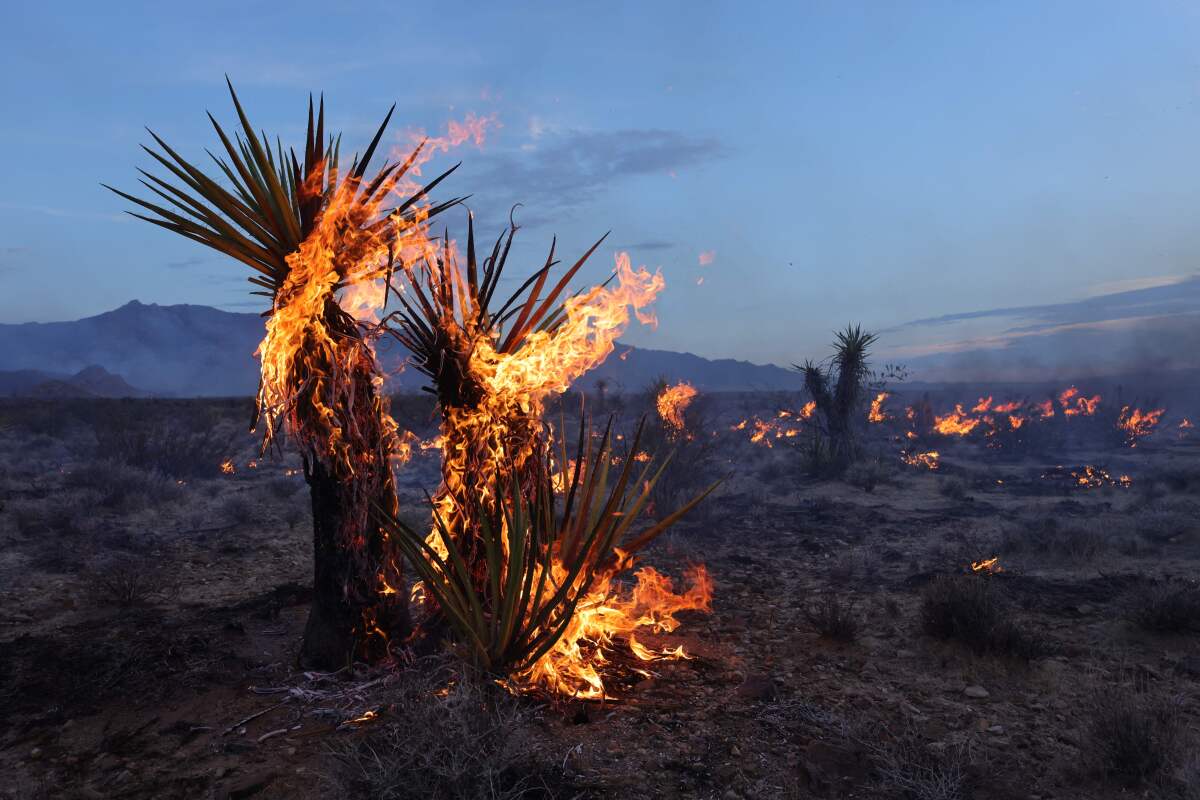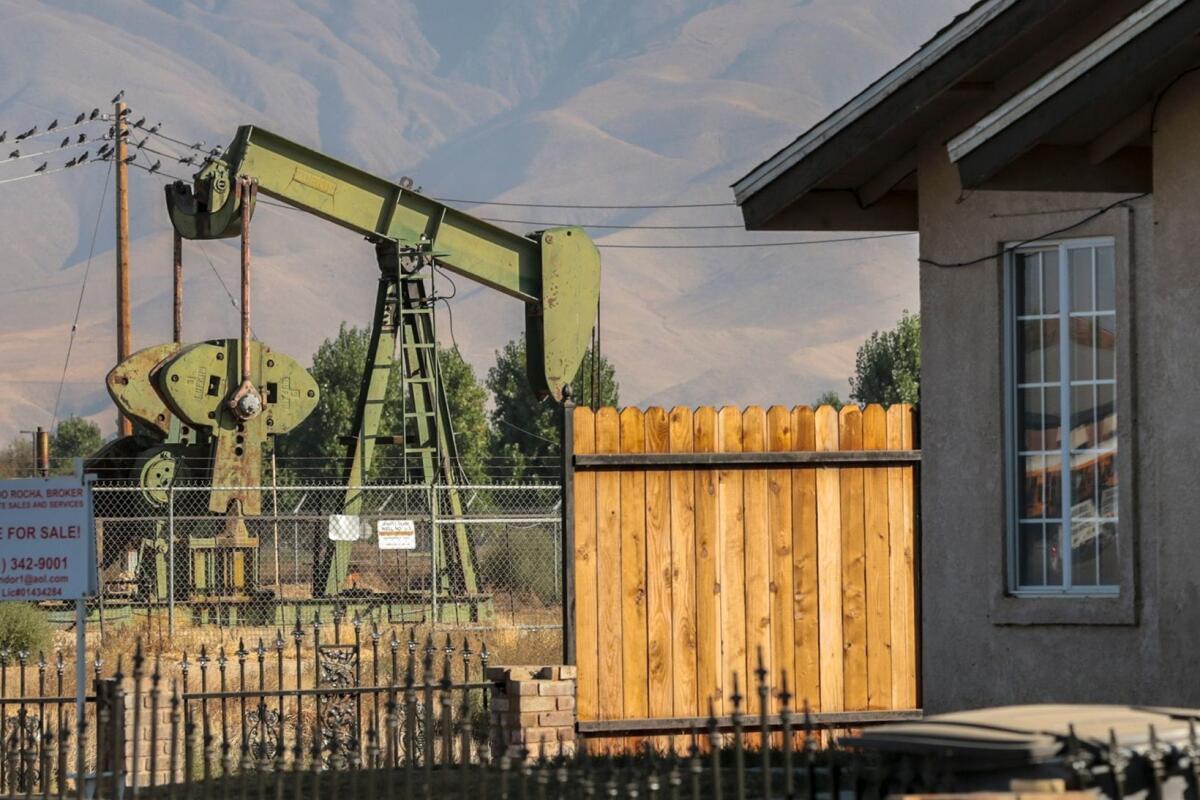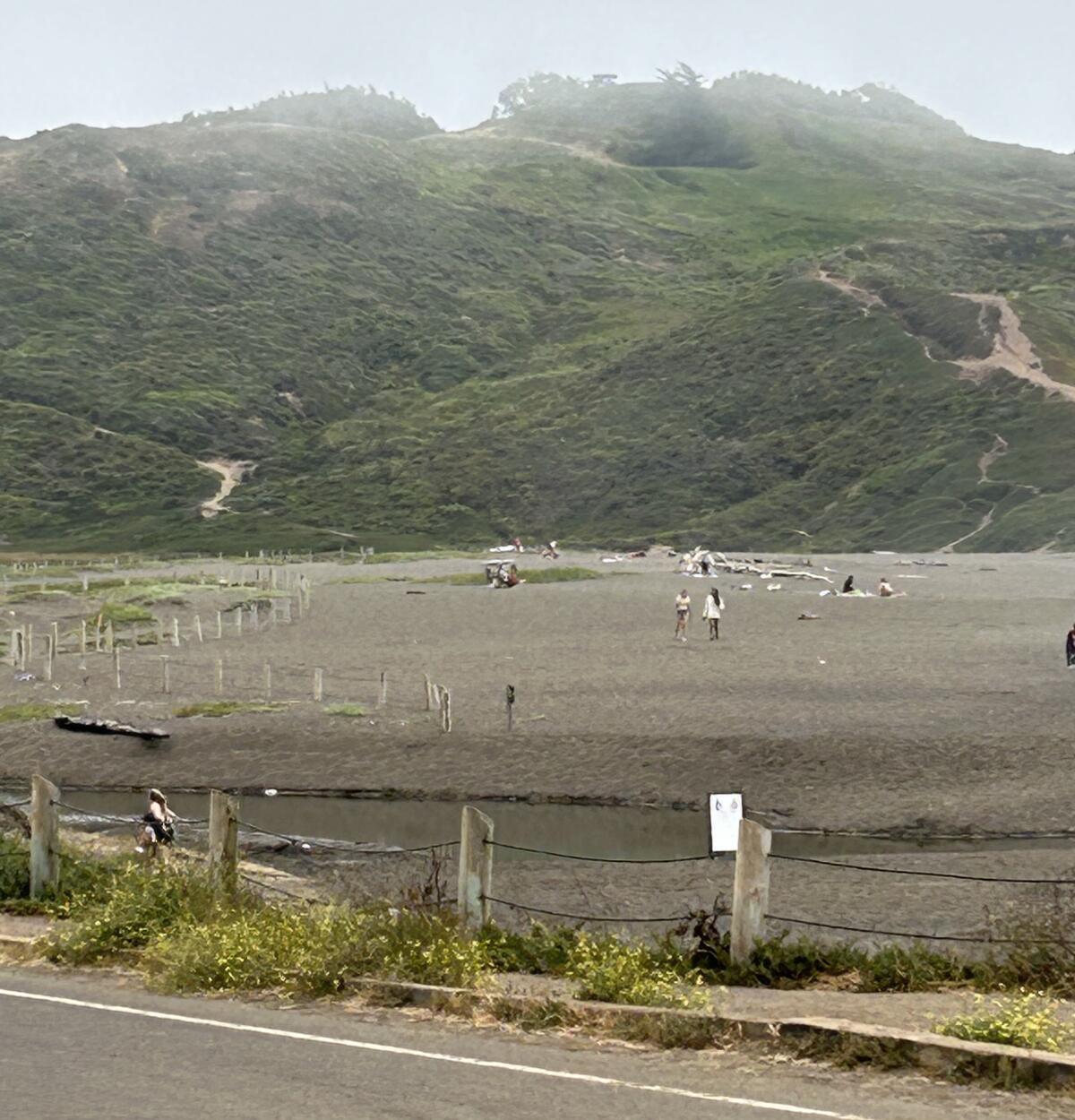As Mojave Desert burns, we’re seeing the flip side of California’s weird weather year

- Share via
Good morning, and welcome to the Essential California newsletter. It’s Thursday, August 3.
The York fire burning in the Mojave Desert has scorched more than 82,000 acres and was 30% contained as of Wednesday afternoon.
Firefighters have been dealing with volatile conditions, including extreme heat and strong winds. Crews also have to deal with so-called fire whirls, “a vortex of flames and smoke that forms when intense heat and turbulent winds combine, creating a spinning column of fire,” according to National Park Service officials with the Mojave National Preserve.
While the extent of the damage is not yet known, park officials report many native plants have been lost, including the delicate Joshua trees found primarily in the Mojave. The blaze has most likely caused irrevocable damage to the desert ecosystem, according to park officials and ecologists.
The York fire is the state’s largest blaze in what had been a slower start to the fire season. But as temperatures soared in July, more fires broke out around the state.
So what can Californians expect as our fire season continues into the late summer and fall?
Our ‘unusual year’ created uneven conditions
To learn more, I spoke with the multi-titled Glen MacDonald. He’s a geology professor at UCLA, the director of the White Mountain Research Center and a co-investigator of the Department of the Interior’s Southwest Climate Adaptation Science Centers. He studies fire from a historical perspective, looking at long-term records to better understand their relationship to climate, vegetation and human activity.
MacDonald explained that while our “unusual year” threw regional weather expectations for a loop and tamped down the early part of our fire season, it created contrasting conditions based on geography.
Though our record-breaking winter precipitation and the cool spring that followed kept a lot of moisture in the mountains and along the coast, he noted that “it would be a really big mistake to feel that we’ve dodged a bullet” when it comes to lower-elevation regions. He pointed to the York fire as an example, driven by two related factors.
First, all that rain led to heavy vegetation growth, producing “a lot of fine fuels” in the form of grasses and shrubs, he said. Then came July, the hottest month ever recorded globally, which dried out much of the vegetation.
“At lower elevations, very high temperatures [have] set the stage,” MacDonald said. “The fuels are ready to go.”
And in Southern California, he noted, our fire season has extended into winter in recent years, which could very well be on tap for the region again as we enter the back half of 2023.
“If you look at some of your really big fires, they’re late in the fall and they can burn right into the next year,” he said. “We’ve got plenty of time to dry these fuels further if we don’t get precipitation in the fall.”
What do the recent decades show?
MacDonald and fellow researchers spent two years analyzing data on annual burn acreage and the number of wildfires in California from 1980 to 2020. Across those 40 years, they saw a “statistically significant trend” of more acreage burned, he said.
That analysis culminated with 2020, in which more than 4 million acres burned across California — the most in modern state history.
“We also saw, though, that the number of reported fires does not increase over that period — in fact, it actually goes down,” MacDonald told me. “So what you’re getting is a trend towards more of the state being burned and bigger fires ... being more and more important in that total annual area burned.”
And “significantly correlated” with that upward trend in scorched earth are increasing temperatures, he noted.
Living with fire
For MacDonald, California shouldn’t be going to war against fires, but rather accepting that “we have to live with fire.”
“Fire is a natural part of our ecosystems,” he said. “It actually fulfills many important ecological functions ... We’re never going to live in a state that is not fire-prone.”
And given our own key role altering the climate thanks to all our emitting, MacDonald said, we’re only “setting ourselves up ... for greater vulnerability on our part to fire.” The solution? Planning for that reality, he explained:
“That means fire-resistant buildings, defensible spaces [and] our community planning has to take into account fire as an ever-present threat here. We have to leave behind the idea that we can suppress the fires and [if] we can throw enough money and resources at this, we’ll get past it. We can’t, so we have to plan for it.”
If you haven’t seen it, The Times maintains a map tracking the progress of wildfires currently burning in California. You can find it here.
And now, here’s what’s happening across California:
Note: Some of the sites we link to may limit the number of stories you can access without subscribing.
L.A. STORIES
A madam at Chinese massage parlors in the San Gabriel Valley was being tried on federal sex trafficking charges. But for prosecutors to secure a conviction against her, as Times reporter Michael Finnegan writes, they’d need to prove the woman “used threats of force, fraud or coercion to cause a victim to engage in prostitution.” Here’s his story on how she ran her businesses and beat those charges. Los Angeles Times
After recent shootings in Watts that killed two people and injured nine others, community leaders are urging residents not to gather in large groups for the rest of the year. Gang interventionists say the shootings were probably fueled by disrespectful posts on social media and called for “unity within the community.” Los Angeles Times
One L.A. developer well-versed in local zoning rules has been buying up single-family homes and making plans for multi-storied, multi-family projects in their place. Akhilesh Jha “is taking advantage of an opportune moment,” writes Times reporter Liam Dillon, “when California politics are turning away from the slow-growth mantra that has dominated in established cities and suburbs over the last half century.” Los Angeles Times
POLITICS AND GOVERNMENT

Environmental groups are gathering signatures in hopes of getting a measure on the November 2024 ballot that would require buffer zones around new oil wells. That’s in response to a referendum already set for that ballot pushed by oil company interest groups that seeks to overturn a law Gov. Gavin Newsom signed banning new wells within 3,200 feet of schools, homes and buildings open to the public. Los Angeles Times
Taylor Swift is set to kick off her six-night Eras tour shows in Inglewood tonight. But a group of state and local leaders are asking the superstar to postpone her shows in solidarity with striking hotel workers. Based on the line of Swifties already camped out for merch at SoFi Stadium, it appears the shows will go on. Los Angeles Times
TRANSPORTATION AND MOBILITY
The light-controlled onramp is a common feature of SoCal freeways. But what exactly do they accomplish in terms of the region’s crippling traffic congestion? The Times’ Utility Journalism Senior Editor Jon Healey dived in to find out. Los Angeles Times
Long Beach is the latest California city working to launch an e-bike lending program, with a goal of allowing residents to check out bikes for up to three months — plus helmets and locks — free of charge. The effort “reflects a surge in state and municipal programs to provide environmentally friendly modes of travel, including e-bikes, electric cars and zero-emission buses,” my colleague Vanessa Arredondo wrote. Los Angeles Times
Support our journalism
CRIME, COURTS AND POLICING
The blowback against the Temecula Valley Unified School District continues. This time, it comes in the form of a lawsuit from the public interest law firm Public Counsel, which claims the district’s ban on critical race theory and other restrictions on teaching about racism violates the California Constitution. Los Angeles Times
Three people were convicted Monday of abusing severely disabled adults at an unlicensed facility in Riverside. California Atty. Gen. Rob Bonta said the victims “suffered horrific neglect” that left them “emaciated and dehydrated.” Los Angeles Times
Free online games
Get our free daily crossword puzzle, sudoku, word search and arcade games in our new game center at latimes.com/games.
AND FINALLY
Today’s California landmark is from Amarjit Aulakh of San Rafael: Rodeo Beach in the Golden Gate National Recreation Area.

Aulakh writes:
Rodeo Beach in Marin County has breathtaking views and excellent hiking trails. You access the [free] beach by driving through the historic Fort Baker-Berry tunnel, which was built in 1918. It’s good to visit all year and very popular with surfers and tourists from all over the world. Dogs are allowed and there are picnic tables, showers, water fountain and restrooms. Enjoy!
What are California’s essential landmarks? Fill out this form to send us your photos of a special spot in California — natural or human-made. Tell us why it’s interesting and what makes it a symbol of life in the Golden State. Please be sure to include only photos taken directly by you. Your submission could be featured in a future edition of the newsletter.
Please let us know what we can do to make this newsletter more useful to you. Send comments to [email protected].
Sign up for Essential California
The most important California stories and recommendations in your inbox every morning.
You may occasionally receive promotional content from the Los Angeles Times.




